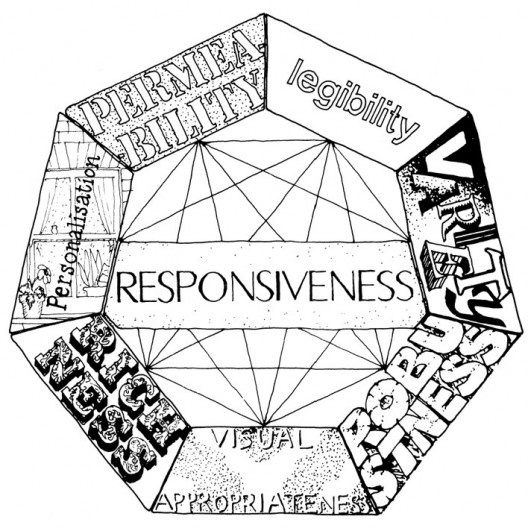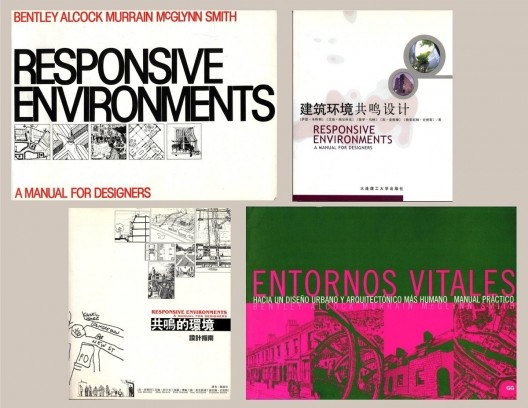
The key urban design qualities discussed in the RE
BENTLEY et al., 1985, p.9
Paula Barros: What motivated you to write “Responsive Environments: a manual for designers” (Architectural Press, 1985)?
Ian Bentley: Three things. Firstly a growing awareness that any built environment is inevitably a political system, in the sense that its physical/spatial form (quite apart from how it is produced or managed) makes some things easy to do, and others more difficult. Secondly a desire to use this awareness as the basis for constructing a conceptual framework of design qualities that could make a “big picture” out of all the fragments of practical design guidance that had been developed by the earlier generation of Jane Jacobs, Kevin Lynch and others. Thirdly the desire to “demystify” the practice of design; to open it up to the understanding of people outside the authors” own professional cultures (with hindsight, I think this came partly from the need to communicate between ourselves, since we came from varied backgrounds in architecture, property development, landscape, planning and art).
PB: RE discussed how permeability, variety, legibility, robustness, visual appropriateness, richness and personalisation influence the choices people can make. How readily may these qualities guide the practice of urban design in fast growing economies, such as Brazil?
IB: I think the interpretation of these qualities, the question of whether others are needed or whether some of the established qualities are unimportant, and the search for the best balance between them, are always matters for debate in any culture/climate/political economy. RE has been published in many languages, so it is particularly important to stress that the book is not a Bible, but a framework for debate, and a practical tool for creative use. I think, therefore, that this question can best be answered, in relation to Brazil, by Brazilians.
PB: Do you consider that the urban design qualities described in RE are necessarily equally relevant as far as the design of a space meant to be responsive is concerned or their relevance change depending on the sorts of activities such space is expected to sustain? In other words, can we say that the urban design qualities described in the RE as the ones that influence the choices people can make have a relative and not absolute importance since responsive environments may be classified under different categories depending of the sorts of activities it is expected to support?
IB: Certainly the relative importance of these qualities changes from one design situation to another, but I don”t think this is only in relation to activities. It seems to me that other aspects of culture must also be important in deciding which qualities matter most in any particular place.
PB: RE provides a set of practical design guidelines to generate responsive spaces, defined as those that provide their users “with an essentially democratic setting, enriching their opportunities by maximizing the degree of choice available to them” (11). If different people place different demands on urban environments, to what extent can urban design tackle the challenge of accommodating conflicting needs and expectations?
IB: At the level of spatial design, I think that the best approach is to try to make all the levels of urban form as resilient as possible – the opposite of the functionalist approach of wrapping spaces tightly round some fixed pattern of activities. The problem is how to do this without creating an anonymous “flexible” space that doesn”t actually lend itself to any real uses at all. I find it very useful to ask a set of questions to broaden ideas about possible uses –Who might be there? Why? What might they want to do? When? Where would it be best to do it? What design supports might help? What are the possibilities for positive/negative interactions between these people and their activities? The results can then be used to dispose the available space-budget in the most positively resilient way we can achieve. We can learn a great deal from happy accidents!
PB: In a recent study carried out by Carmona, twenty urban space types were identified as composing the contemporary scene (12). Since different social groups have different needs, wants and expectations, it is not surprising that they are likely to seek different types of urban gathering spaces, including urban squares, shopping centers, book shops, restaurants and so on. If it is accepted, do you agree that urban open spaces were, are and will necessarily be to a varying degree exclusionary, independently of the design solution adopted?
IB: Inevitably some spaces in any settlement are quite properly exclusionary – I don”t want anyone in my own living space without invitation, for example. Other spaces have a kind of “soft exclusion”, in the sense that they house specific activities that only attract people who share particular interests – art galleries might be a specific example. One of the most interesting changes in the UK in recent years, however, has been the gradual erosion of the boundaries between such cultural activities. I am writing this note, for example, in a café which – no doubt partly for commercial reasons – has also become a gallery where local artists can arrange to exhibit their work; while most of Oxford”s bookshops have also come to include cafes during the last few years. I think this reduces exclusion, because it expands the “offer” of experiences to people who otherwise might see art galleries or bookshops as “not for them”. This seems a small but significant step towards thinking of settlements as mind-expanding “social learning systems”, which interests me greatly.
Of course, this anti-exclusionary potential should not be thought about only at the small scale of particular spaces. The significance of expanding “the offer” depends greatly on the extent to which any particular space is integrated into the spatial structure of the district, or of the settlement as a whole. I am in this café at least partly because it is situated on one of Oxford”s most integrated – and therefore least exclusionary – streets; which means that everyone (including me) is constantly reminded of its presence.

The covers of the many translations in different languages of the book Responsive Environments
Photo by the interviewee
PB: Carmona et al. argue that “urban designers cannot make places in any simplistic or deterministic manner, they can increase “the place potential” – the likelihood that people will consider the space a significant and meaningful place” (13). On reflection, which urban design qualities may enhance the place potential?
In my opinion, everywhere is inevitably significant and meaningful, because human beings are so constituted as to read meanings into everything they encounter – this is surely a fundamental aspect of the human condition. The important question is how to make places that have a positive “place potential” I think the answer to this question shifts with historical circumstances.
For example, back in the 1980s – when RE was written – choice seemed “the supreme quality”, as the sociologist Zygmunt Bauman put it. The key qualities around which RE is organised, therefore, are all meant to structure space (of course, space is not all that matters here!) so as to open up the everyday life-choices of as large a proportion of people as possible.
By the 1990s, it began to be clear, paradoxically, that the very “supremacy” of choice was itself having a destabilising impact on many people”s life-experiences. It began to be clear that if choice really was the supreme quality, then there was an obvious need for a choice of ways of choosing, and a choice of ways of choosing how to choose how to choose – and so on, spiralling down what philosophers call an “infinite regress”; which left no firm foundation for making any choices at all.
In this scary situation, we see the growth of a countervailing desire for a sense of rootedness; specifically to counter what the novelist Milan Kundera had aptly called “the unbearable lightness of being”. Because it “enfolds” us, and “feels” solid and long-lasting, the cultural landscape of urban form is a powerful medium for constructing a sense of roots – concepts like “local and regional identity” and “traditional neighbourhood development” move nearer to the cultural centre ground; sometimes degenerating into a rather disempowering nostalgia.
With climate change and the inescapable evidence of ecological degradation giving rise to fears about the quality of the world we are bequeathing to future generations, the natural world, too, becomes a medium for constructing a sense of roots. Supported by influential literature about “biophilia”, “Landscape Urbanism” moves centre stage.
The interesting thing, it seems to me, is that we are now at a juncture where all these values – RE, traditional urban form, local distinctiveness, landscape urbanism – are concurrently important. They have not displaced each other, but rather have overlaid each other over time, like the growth rings of a tree. My INSD colleagues and I are now trying to synthesise them into a more coherent set of concepts that we call the “EcoResponsive Environments” approach.
PB: How has the “Landscape Urbanism” theory impelled you to reconsider the set of key principles discussed in RE as important to inform a socially-responsive approach to design of urban open spaces?
IB: So far as my own thinking is concerned, the key contribution of landscape urbanism has been to awaken settlement designers to the understanding (which now, in retrospect, seems obvious!) that any human settlement is a type of cultural landscape – a natural landscape altered through human intervention. This raises all sorts of important questions about how blue and green structures might best be integrated into urban layouts, to the benefit of the wider ecosphere as well as for the human inhabitants. Landscape urbanism has done settlement design a great service by raising these questions.
From my own perspective, however, the questions raised often seem more important than the particular design answers that have been suggested within the landscape urbanism movement itself. INSD”s own EcoResponsive approach tries to address these questions by integrating the well-established principles of RE with the ideas of landscape ecology, as developed by Richard Forman and others. At a conceptual level, we find that our attempt at this integration has been greatly helped by landscape ecology”s understanding of landscapes as formed from spatial elements such as patches, corridors and matrices; which we see as analogous to the buildings, plots, streets and so forth with which we are familiar in the human realm.
note
11
MARSHALL, Stephen. Cities, Design & Evolution. London: Routledge, 2009, p. 6.
12
Carmona, Matthew. Contemporary public space, part two: classification. Journal of Urban Design, Londres, v.15, n. 2, maio 2010. Disponível em: <www.tandf.co.uk/journals/titles/13574809.asp>. Acesso em: 24 fev. 2010.
13
CARMONA, Matthew et al. Public places urban spaces: the dimensions of urban design. 2. ed. Amsterdam: Architectural Press, 2010, p.123.



